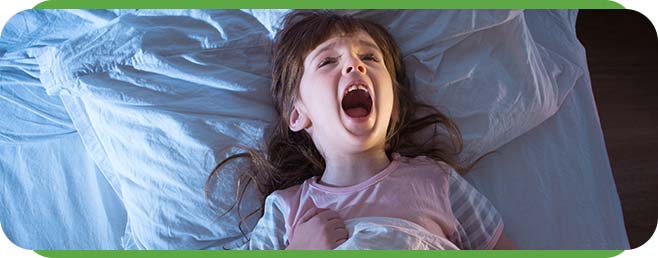Tips for Helping a Child Dealing With Parasomnia
Is your child suffering from parasomnia? The common symptoms to identify parasomnia are sleepwalking, bedwetting, sleep talking, nightmares, and bruxism. If these symptoms are consistent, bring your little one to our sleep center. Contact Koala® Center For Sleep & TMJ Disorders for more information or book an appointment online. We have convenient locations across the U.S. in Bloomington IL, Peoria/Dunlap IL, El Paso TX, and Wausau WI.


Table of Contents:
What are the symptoms of parasomnia in children?
What can you do for kids with parasomnia?
Can childhood trauma cause parasomnia?
What is the difference between parasomnia and night terror?
Parasomnia in children can appear in various ways. For this reason, recognizing the specific symptoms and their frequency is crucial for early detection and appropriate intervention. Some common symptoms of parasomnia in youth include:
– Sleepwalking – Children may get out of bed and walk around while still asleep, often with a blank or glassy-eyed expression. It’s typical for them to have no recollection of these events the following morning.
– Bedwetting – This condition presents as accidental urination during sleep after the child has already achieved bladder control during the day.
– Nightmares – It’s common for kids to experience intense or frightening dreams that cause distress and disrupt sleep.
– Sleep talking – This condition is characterized by talking or mumbling during sleep, which may or may not be coherent.
– Sleep terrors – Sleep terrors are episodes of sudden waking with intense fear, often accompanied by screaming, sweating, and rapid heart rate.
If you notice any of these symptoms in your child, it’s advised to consult a pediatric sleep team to receive an accurate diagnosis and effective management of any underlying conditions. Consulting a knowledgeable team member at Koala® Center For Sleep & TMJ Disorders will ensure your child develops healthy sleep patterns and will improve their overall wellness.
For children experiencing parasomnia, there are several strategies to manage and improve their sleep patterns. The most effective approach depends on the specific type and severity of parasomnia. Some general steps that can be taken to alleviate frustrating symptoms include:
– Consult a pediatric sleep team – If parasomnia is causing significant disruption to the child’s sleep or daily life, it’s best to seek guidance from a sleep team. This is crucial to determine the best course of action and various treatment options to reduce your child’s discomfort.
– Create a sleep-conducive environment – You should ensure your child’s bedroom is comfortable, quiet, and conducive to a restful sleep environment.
– Establish a consistent bedtime routine – Creating a calming and predictable routine before bedtime will help signal to the child that it’s time to wind down and prepare for sleep.
– Monitor sleep patterns – It’s wise to keep a sleep diary to track the frequency and triggers of parasomnia episodes. This will provide valuable information to healthcare professionals about the nature of your child’s condition.
– Address stress and anxiety – If stress or anxiety is a contributing factor to parasomnia, consider implementing relaxation techniques and seeking professional support.
– Implement safety measures – For parasomnias such as sleepwalking or night terrors, it’s wise to take precautions to keep the child safe during these episodes.
Yes, childhood trauma can be a contributing factor to the development of parasomnia. Trauma, such as experiencing or witnessing a distressing event, can disrupt sleep patterns and manifest as various parasomnias. These sleep disturbances most often include night terrors, nightmares, sleepwalking, and sleep talking.
Trauma can negatively impact a child’s emotional well-being and lead to heightened stress and anxiety levels. This can contribute to the development of parasomnia episodes. Furthermore, the brain’s response to trauma often affects sleep regulation, which leads to disruptions in sleep-wake cycles. Our team recognizes the link between childhood trauma and parasomnia and provides comprehensive support and care for children experiencing various sleep-related conditions.
The term “parasomnia” refers to a variety of sleep disorders such as sleepwalking, sleep talking, sleep eating, and nightmares. These behaviors can occur at different stages of sleep and are often disruptive to the person experiencing them. Night terrors are a specific type of parasomnia that typically occurs during non-REM sleep. Night terrors are characterized by sudden awakenings during the night with feelings of intense fear or distress, sometimes accompanied by physical actions such as screaming or thrashing. Unlike nightmares, which are vivid dreams that can be recalled upon waking, people with night terrors often have no memory of the episode.
In summary, parasomnia is a broad category of sleep disorders and includes night terrors, which are a specific type of sleep disturbance. To receive support for sleep disturbances such as night terrors, it’s recommended to seek guidance from a dedicated sleep team. Our knowledgeable team can accurately identify the specific sleep disorder affecting your child’s sleep and wellness and develop a tailored treatment strategy to manage their symptoms.

Additional Services You May Need
▸ KoalaKIDZzz®
▸ Sleep Apnea
▸ Snoring
▸ TMJ Disorder
▸ Fatigue
▸ Sleep Disorders
▸ Weight Loss
▸ CPAP Alternative
▸ Oral Appliances




